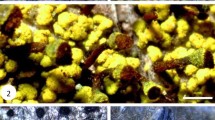Abstract
25 species of lichens have been collected in semidesertic to desertic areas of Iran. On the basis of spatial relations to the substrate and anatomical features of the thallus three main groups (one with a subdivision based on colour and morphology of the thallus) can be differentiated. Selective advantages and peculiarities in connection with the desert habitat are pointed out, such as inverse thallus-structure, a dense network of skeletal hyphae in the substrate in otherwise epilithic species, proliferating areolae of the thallus, immersed pycnidia with trichogynes and brownish spores in groups with usually colourless spores. Most of the species are wide-spread in arid and often also in humid regions; only one species,Verrucaria buschirensis J. Steiner, seems to be endemic. The prevalence of cyanophilic lichens in deserts may have phylogenetic reasons, as these groups appear to date back to periods without higher vegetation and a desert-like environment.
Similar content being viewed by others
Literatur
Faurel, L., Ozenda, P., Schotter, G., 1953: Les lichens du Sahara algérien. — Desert Research. Proc. Intern. Symp. Res. Counc. Israel, Spec. Publ.2, 310–317.
Friedmann, E. I., &Galun, Margalith, 1974: Desert algae, lichens and fungi. InBrown, G. W., jr. (Ed.): Desert biology2, 164–212. — New York and London: Academic Press.
Galun, Margalith, 1963: Autecological and synecological observations on lichens of the Negev, Israel. — Isr. J. Bot.12, 179–187.
, 1966: Additions to the lichen flora of the Negev, Israel. — Isr. J. Bot.15, 144–149.
, 1960: A study of lichens of the Negev. — Bull. Res. Counc. Israel9 D, 127–148.
Grummann, V., 1963: Catalogus lichenum Germaniae. VII + 207 S., 2 Tafeln. — Stuttgart: Gustav Fischer.
Henssen, Aino, 1963: Eine Revision der FlechtenfamilienLichinaceae undEphebaceae. — Symb. Bot. Uppsal.18/1, 1–123, 31 Tafeln.
Herre, A. W., 1911: The desert lichens of Reno, Nevada. — Bot. Gaz. (Chicago)51, 286–297.
James, P. W., 1965: A new check-list of British lichens. — Lichenologist3, 95–153.
Kukkonen, I., 1963: Taxonomic studies on the genusAnthracoidea (Ustilaginales). — Ann. Soc. Zool. Bot. Fenn. “Vanamo”34 (3), 1–122.
Lange, O. L., 1953: Hitze- und Trockenresistenz der Flechten in Beziehung zu ihrer Verbreitung. — Flora (Jena), Abt. B140, 39–97.
Logan, R. F., 1968: Causes, climates and distributions of deserts. InBrown, G. W. (Ed.): Desert biology1, 21–50. — New York, London: Academic Press.
Magnusson, A. H., 1940–1944: Lichens from Central Asia. Reports from the scientific expedition to the north-western provinces of China under the leadership of Dr.Sven Hedin, Sino-Swedish Expedition. — Publ.13, XI. Botany,1 and Publ.22, XI. Botany2. — Stockholm.
Riedl, H., 1979: Untersuchungen über das Verhältnis von Rotalgen der GattungHildenbrandia zu wasserbewohnendenVerrucaria-Arten. — Ann. Naturh. Museum Wien82, in Vorbereitung.
Savile, B. D. O., 1954: The fungi as aids in the taxonomy of the flowering plants. — Science120, 583–585.
Scott, G. D., 1967: Studies of the lichen symbiosis: 3. The water relations of lichens on granite kopjes in central Africa. — Lichenologist3, 368–385.
Szatala, Ö., 1957: Prodromus einer Flechtenflora des Irans. — Ann. Hist. Natur. Mus. Nat. Hung.8 (s. n.), 101–154.
Vogel, St., 1955: Niedere „Fensterpflanzen“ in der südafrikanischen Wüste. — Beitr. Biol. Pflanzen31, 45–135.
Weber, W. A., 1962: Environmental modification and the taxonomy of the crustose lichens. — Sv. Bot. Tidskr.56, 293–333.
Zschacke, H., 1934:Epigloeaceae, Verrucariaceae undDermatocarpaceae. In Dr.L. Rabenhorst's Kryptogamen-Flora von Deutschland, Österreich und der Schweiz. 2. Aufl.,9/I/I: 4, 6–695. — Leipzig: Akademische Verlagsgesellschaft m. b. H.
Author information
Authors and Affiliations
Additional information
Herrn Prof. Dr. L.Geitler zum 80. Geburtstag gewidmet.
Rights and permissions
About this article
Cite this article
Riedl, H. Präadaption bei Flechten iranischer Halbwüsten. Pl Syst Evol 131, 217–233 (1979). https://doi.org/10.1007/BF00984255
Received:
Issue Date:
DOI: https://doi.org/10.1007/BF00984255




